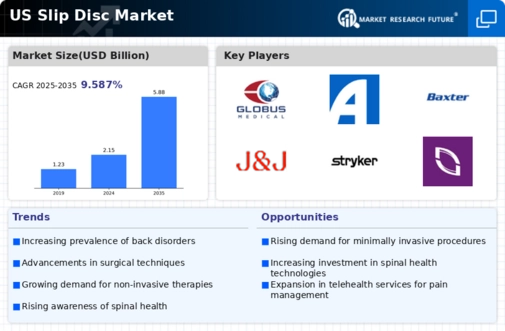Growth of Rehabilitation Services
The expansion of rehabilitation services is significantly influencing the slip disc market. As more patients seek non-surgical options for managing their conditions, the demand for physical therapy and rehabilitation programs is on the rise. These services play a crucial role in recovery and pain management, often serving as a first line of defense against surgical interventions. Data suggests that the physical therapy market is projected to reach $45 billion by 2027, reflecting a growing recognition of its importance in treating musculoskeletal disorders, including slip discs. This trend indicates that rehabilitation services are likely to become increasingly integrated into treatment plans, thereby driving growth in the slip disc market as patients prioritize holistic approaches to recovery.
Increased Awareness and Education
The rise in awareness and education regarding spinal health is a critical driver for the slip disc market. Public health campaigns and educational initiatives have been instrumental in informing individuals about the risks associated with poor posture, sedentary lifestyles, and improper lifting techniques. This heightened awareness is likely to lead to earlier diagnosis and treatment of slip disc conditions. Moreover, healthcare professionals are increasingly emphasizing preventive measures, which may reduce the incidence of severe cases requiring extensive treatment. As a result, the slip disc market could see a surge in demand for both conservative and surgical treatment options. The potential for early intervention may not only improve patient outcomes but also alleviate the economic burden associated with advanced slip disc cases.
Rising Incidence of Back Disorders
The increasing prevalence of back disorders, particularly among the aging population, is a notable driver in the slip disc market. As individuals age, the likelihood of developing conditions such as herniated discs rises significantly. Data indicates that approximately 80% of adults experience back pain at some point in their lives, with a substantial portion attributed to disc-related issues. This trend suggests a growing demand for effective treatment options within the slip disc market. Furthermore, the aging demographic in the US is projected to reach 77 million by 2034, intensifying the need for medical interventions and therapies targeting slip disc conditions. Consequently, healthcare providers are likely to invest more in innovative solutions, thereby propelling the slip disc market forward.
Advancements in Surgical Techniques
Innovations in surgical techniques are transforming the landscape of the slip disc market. Minimally invasive procedures, such as endoscopic discectomy, have gained traction due to their reduced recovery times and lower complication rates. These advancements not only enhance patient outcomes but also contribute to a growing acceptance of surgical interventions for slip disc treatment. According to recent data, the market for minimally invasive spine surgery is expected to grow at a CAGR of 7.5% through 2027. This growth indicates a shift in patient preferences towards less invasive options, which may lead to increased demand for surgical solutions within the slip disc market. As healthcare facilities adopt these advanced techniques, the overall market is likely to experience significant expansion.
Technological Integration in Treatment Modalities
The integration of technology into treatment modalities is emerging as a pivotal driver in the slip disc market. Innovations such as telemedicine, wearable health devices, and advanced imaging techniques are enhancing patient care and treatment efficacy. Telehealth services, for instance, allow patients to consult with specialists remotely, improving access to care and facilitating timely interventions. Additionally, wearable devices that monitor spinal health can provide valuable data for both patients and healthcare providers. This technological evolution is likely to foster a more proactive approach to managing slip disc conditions, potentially leading to better outcomes. As these technologies become more prevalent, the slip disc market may experience a notable shift towards more personalized and efficient treatment strategies.






















Leave a Comment